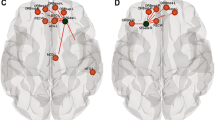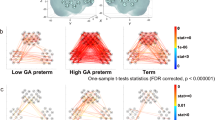Abstract
Introduction
Resting state networks are proposed to reflect the neuronal connectivity that underlies cognitive processes. Consequently, abnormal behaviour of these networks due to disease or altered development may predict poor cognitive outcome. To understand how very preterm birth may affect the development of resting state connectivity, we followed a cohort of very preterm-born infants from birth through to 4 years of age using resting state functional MRI.
Methods
From a larger longitudinal cohort of infants born very preterm (<32 weeks gestational age), 36 at birth, 30 at term, 21 two-year and 22 four-year resting state fMRI datasets were acquired. Using seed-based connectivity analyses with seeds in the anterior cingulate cortex, posterior cingulate cortex, left and right motor-hand regions and left and right temporal lobes, we investigated local and inter-region connectivity as a function of group and age.
Results
We found strong local connectivity during the preterm period, which matured into inter-hemispheric and preliminary default-mode network correlations by 4 years of age. This development is comparable to the resting state networks found in term-born infants of equivalent age.
Conclusion
The results of this study suggest that differences in developmental trajectory between preterm-born and term-born infants are small and, if present, would require a large sample from both populations to be detected.



Similar content being viewed by others
References
Biswal B, Yetkin FZZ, Haughton VM, Hyde JSS (1995) Functional connectivity in the motor cortex of resting human brain using echo-planar MRI. Magnet Reson Med 34(4):537–41
Fox MD, Raichle ME (2007) Spontaneous fluctuations in brain activity observed with functional magnetic resonance imaging. Nat Rev Neurosci 8(9):700–711
Cohen AL, Fair DA, Dosenbach NUF, Miezin FM, Dierker D, Van Essen DC, Schlaggar BL, Petersen SE (2008) Defining functional areas in individual human brains using resting functional connectivity MRI. NeuroImage 41(1):45–57
Damoiseaux JS, Rombouts SaRB, Barkhof F, Scheltens P, Stam CJ, Smith SM, Beckmann CF (2006) Consistent resting-state networks across healthy subjects. Proc Natl Acad Sci USA 103(37):13848–13853
Smith SM, Fox PT, Miller KL, Glahn DC, Fox PM, Mackay CE, Filippini N, Watkins KE, Toro R, Laird AR, Beckmann CF (2009) Correspondence of the brain’s functional architecture during activation and rest. Proc Natl Acad Sci U S A 106(31):13040–13045
Cordes D, Haughton VM, Arfanakis K, Wendt GJ, Turski PA, Moritz CH, Quigley MA, Meyerand ME (2000) Mapping functionally related regions of brain with functional connectivity MR imaging. AJNR Am J Neuroradiol 21(9):1636–1644
Raichle M, MacLeod A (2001) A default mode of brain function. Proc Natl Acad Sci U S A 98(2):676–682
Greicius MD, Krasnow B, Reiss AL, Menon V (2003) Functional connectivity in the resting brain: a network analysis of the default mode hypothesis. Proc Natl Acad Sci U S A 100(1):253–258
Filippini N, MacIntosh BJ, Hough MG, Goodwin GM, Frisoni GB, Smith SM, Matthews PM, Beckmann CF, Mackay CE (2009) Distinct patterns of brain activity in young carriers of the APOE-epsilon4 allele. Proc Natl Acad Sci U S A 106(17):7209–7214
Damoiseaux JS, Prater KE, Miller BL, Greicius MD (2012) Functional connectivity tracks clinical deterioration in Alzheimer’s disease. Neurobiol Aging 33(4):828e19–30
Fair DA, Cohen AL, Dosenbach NUF, Church JA, Miezin FM, Barch DM, Raichle ME, Petersen SE, Schlaggar BL (2008) The maturing architecture of the brain’s default network. Proc Natl Acad Sci U S A 105(10):4028–4032
Fair DA, Cohen AL, Power JD, Dosenbach NUF, Church JA, Miezin FM, Schlaggar BL, Petersen SE (2009) Functional brain networks develop from a ‘local to distributed’ organization. PLoS comput biol 5(5):e1000381
Fair DA, Bathula D, Mills KL, Dias TGC, Blythe MS, Zhang D, Snyder AZ, Raichle ME, Stevens AA, Nigg JT, Nagel BJ (2010) Maturing thalamocortical functional connectivity across development. Front Syst Neurosci 4:10
Fransson P, Aden U, Blennow M, Lagercrantz H (2011) The functional architecture of the infant brain as revealed by resting-state fMRI. Cereb Cortex 21:145–154
Fransson P, Skiöld B, Horsch S, Nordell A, Blennow M, Lagercrantz H, Aden U (2007) Resting-state networks in the infant brain. Proc Natl Acad Sci U S A 104(39):15531–15536
Fransson P, Skiöld B, Engström M, Hallberg B, Mosskin M, Aden U, Lagercrantz H, Blennow M (2009) Spontaneous brain activity in the newborn brain during natural sleep—an fMRI study in infants born at full term. Pediatr Res 66(3):301–305
Lin W, Zhu Q, Gao W, Chen Y, Toh C-H, Styner M, Gerig G, Smith JK, Biswal B, Gilmore JH (2008) Functional connectivity MR imaging reveals cortical functional connectivity in the developing brain. AJNR Am J Neuroradiol 29(10):1883–1889
Liu W-C, Flax JF, Guise KG, Sukul V, Benasich A a (2008) Functional connectivity of the sensorimotor area in naturally sleeping infants. Brain Res 1223:42–49
Gao W, Zhu H, Giovanello KS, Smith JK, Shen D, Gilmore JH, Lin W (2009) Evidence on the emergence of the brain’s default network from 2-week-old to 2-year-old healthy pediatric subjects. Proc Natl Acad Sci U S A 106(16):6790–6795
Kostović I, Jovanov-Milosević N (2006) The development of cerebral connections during the first 20–45 weeks’ gestation. Semin Fetal Neonatal Med 11(6):415–422
Bhutta A, Cleves M et al (2002) Cognitive and behavioral outcomes of school-aged children who were born preterm: a meta-analysis. JAMA 288(6):728–737
Aarnoudse-Moens CSH, Smidts DP, Oosterlaan J, Duivenvoorden HJ, Weisglas-Kuperus N (2009) Executive function in very preterm children at early school age. J Abnorm Child Psychol 37(7):981–993
Saigal S, Doyle LW (2008) An overview of mortality and sequelae of preterm birth from infancy to adulthood. Lancet 371(9608):261–269
Moster D, Lie RT, Markestad T (2008) Long-term medical and social consequences of preterm birth. N Engl J Med 359(3):262–273
Smyser CD, Inder TE, Shimony JS, Hill JE, Degnan AJ, Snyder AZ, Neil JJ (2010) Longitudinal analysis of neural network development in preterm infants. Cereb cortex 20:2852–62
Doria V, Beckmann CF, Arichi T, Merchant N, Groppo M, Turkheimer FE, Counsell SJ, Murgasova M, Aljabar P, Nunes RG, Larkman DJ, Rees G, Edwards AD (2010) Emergence of resting state networks in the preterm human brain. Proc Natl Acad Sci U S A 107(46):20015–20020
Cox RW (1996) AFNI: software for analysis and visualization of functional magnetic resonance neuroimages. Comput Biomed Res 29(3):162–173
Jenkinson M, Beckmann CF, Behrens TEJ, Woolrich MW, Smith SM (2012) Fsl. NeuroImage 62(2):782–790
Lerch JP, Sled JG, Henkelman RM (2011) MRI phenotyping of genetically altered mice. Magnetic Resonance Neuroimaging 711(1):349–361
Arichi T, Moraux A, Melendez A, Doria V, Groppo M, Merchant N, Combs S, Burdet E, Larkman DJ, Counsell SJ, Beckmann CF, Edwards AD (2010) Somatosensory cortical activation identified by functional MRI in preterm and term infants. NeuroImage 49(3):2063–2071
Heep A, Scheef L, Jankowski J, Born M, Zimmermann N, Sival D, Bos A, Gieseke J, Bartmann P, Schild H, Boecker H (2009) Functional magnetic resonance imaging of the sensorimotor system in preterm infants. Pediatrics 123(1):294
Lee W, Donner EJ, Nossin-Manor R, Whyte HEA, Sled JG, Taylor MJ (2012) Visual functional magnetic resonance imaging of preterm infants. Dev Med Child Neurol 54(8):724–729
Erberich SG, Friedlich P, Seri I, Nelson MD Jr, Bl\"uml S (2003) Functional MRI in neonates using neonatal head coil and MR compatible incubator. NeuroImage 20(2):683–692
Kehrer M, Schöning M (2009) A longitudinal study of cerebral blood flow over the first 30 months. Pediatr Res 66(5):560–564
Conflict of interest
We declare that we have no conflict of interest.
Author information
Authors and Affiliations
Corresponding author
Additional information
This article is part of the special supplement “The Premature Brain”—Guest Editor: Charles Raybaud
Rights and permissions
About this article
Cite this article
Lee, W., Morgan, B.R., Shroff, M.M. et al. The development of regional functional connectivity in preterm infants into early childhood. Neuroradiology 55 (Suppl 2), 105–111 (2013). https://doi.org/10.1007/s00234-013-1232-z
Received:
Accepted:
Published:
Issue Date:
DOI: https://doi.org/10.1007/s00234-013-1232-z




